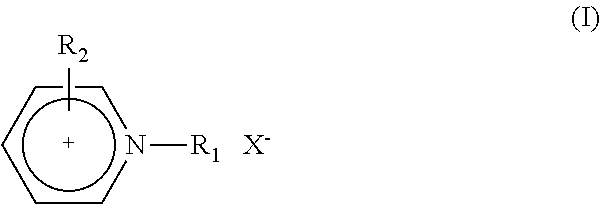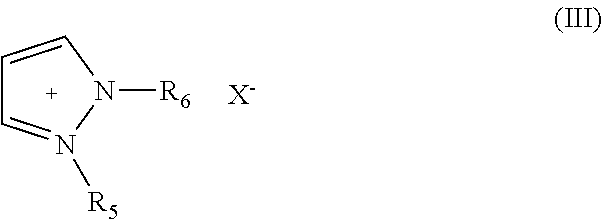Aluminum or aluminum alloy molten salt electroplating bath having good throwing power, electroplating method using the bath, and pretreatment method of the bath
a technology of molten salt and aluminum alloy, which is applied in the direction of electrolysis components, electrolysis processes, cells, etc., can solve the problems of poor handling of bathes, bathes have a risk of explosion, and aluminum electrolysis from an aqueous solution is difficult to achieve, and achieves high corrosion resistance and no explosion or ignition risk
- Summary
- Abstract
- Description
- Claims
- Application Information
AI Technical Summary
Benefits of technology
Problems solved by technology
Method used
Image
Examples
example 1
[0052]A 99.9% Al wire was immersed in a bath obtained by mixing and melting AlCl3 and 1-methyl-3-propylimidazolium bromide at a molar ratio of 2:1, and the bath was heated at 80° C. for 48 hours. After that, the bath was filtrated, and 3 g / L of dimethylamine borane was added, and the bath was heated at 80° C. for 1 hour. Thus, a plating bath was prepared. Next, a Hull cell copper plate (plate thickness: 0.5 mm) to be used as a cathode was subjected to pretreatments including alkali degreasing, electrolytic alkaline cleaning, acid pickling, washing with water, subsequent washing with ethyl alcohol, and drying. While the pretreated copper plate was used as the cathode, and an aluminum plate (purity: 99.9%) was used as the anode, Al plating was conducted in a dry nitrogen gas atmosphere at a bath temperature of 50° C. with a pulse (duty ratio: 1:1, ON and OFF times: 10 ms) of 1 A for 20 minutes. Note that the plating bath was stirred with a stirrer. Table 1 shows the electric conductiv...
example 2
[0053]A 99.9% Al wire was immersed in a bath obtained by mixing and melting AlCl3 and 1-methyl-3-propylimidazolium bromide at a molar ratio of 2:1, and the bath was heated at 80° C. for 48 hours. After that, the bath was filtered, 0.5 g / L of lithium aluminum hydride was added, and the bath was heated at 80° C. for 1 hour. Thus, a plating bath was prepared. Next, a Hull cell copper plate (plate thickness: 0.5 mm) to be used as a cathode was subjected to pretreatments including alkali degreasing, electrolytic alkaline cleaning, acid pickling, washing with water, subsequent washing with ethyl alcohol, and drying. While the pretreated copper plate was used as the cathode, and an aluminum plate (purity: 99.9%) was used as the anode, Al plating was conducted in a dry nitrogen gas atmosphere at a bath temperature of 50° C. with a pulse (duty ratio: 1:1, ON and OFF times: 10 ms) of 1 A for 20 minutes. Note that the plating bath was stirred with a stirrer. Table 1 shows the electric conducti...
example 3
[0054]A 99.9% Al wire was immersed in a bath obtained by mixing and melting AlCl3 and 1-methyl-3-propylimidazolium bromide at a molar ratio of 2:1, and the bath was heated at 80° C. for 48 hours. To the bath, 3 g / L of anhydrous zirconium chloride and 3 g / L of anhydrous manganese chloride were added and dissolved. After that, the bath was filtrated, 3 g / L of dimethylamine borane was added, and the bath was heated at 80° C. for 1 hour. Thus, a plating bath was prepared. Next, a Hull cell copper plate (plate thickness: 0.5 mm) to be used as a cathode was subjected to pretreatments including alkali degreasing, electrolytic alkaline cleaning, acid pickling, washing with water, subsequent washing with ethyl alcohol, and drying. While the pretreated copper plate was used as the cathode, and an aluminum plate (purity: 99.9%) was used as the anode, Al plating was conducted in a dry nitrogen gas atmosphere at a bath temperature of 50° C. with a pulse (duty ratio: 1:1, ON and OFF times: 10 ms)...
PUM
| Property | Measurement | Unit |
|---|---|---|
| Temperature | aaaaa | aaaaa |
| Density | aaaaa | aaaaa |
| Density | aaaaa | aaaaa |
Abstract
Description
Claims
Application Information
 Login to View More
Login to View More - R&D
- Intellectual Property
- Life Sciences
- Materials
- Tech Scout
- Unparalleled Data Quality
- Higher Quality Content
- 60% Fewer Hallucinations
Browse by: Latest US Patents, China's latest patents, Technical Efficacy Thesaurus, Application Domain, Technology Topic, Popular Technical Reports.
© 2025 PatSnap. All rights reserved.Legal|Privacy policy|Modern Slavery Act Transparency Statement|Sitemap|About US| Contact US: help@patsnap.com



